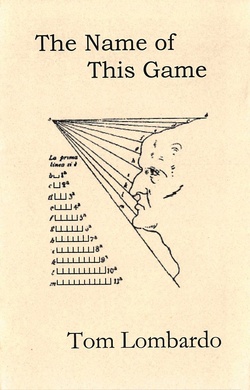Tom Lombardo spent his late teens and early 20s playing football as a running back at a state champion Western Pennsylvania high school, and then at Carnegie-Mellon University in Pittsburgh. Over eight years, he experienced multiple concussions that affected his life during college and afterwards. Of his new poetry collection The Name of This Game David Bottoms says, "These hard-hitting poems get about as close to the violence of football as language can. They are explosive, yet controlled, and they pack a focused punch." Lombardo puts readers in his cleats and in his brain during the games. He is poetry series editor for Press 53.
Loren Kleinman (LK): How did you come up with the title for this collection? What is the story behind the cover design?
Tom Lombardo (TL): A line from one of the poems "The name of this game is to hurt someone" is a metaphor for football. It's a brutal sport. The media are full of stories of sports concussions and the long-term health of participants, but my poems approach concussions from another direction: What does it feel like, what does it taste like, what does it smell like, how does it heal? And what does concussion syndrome mean to the person living with it? And, in the end, do participants get any return at all?
My editor April Ossmann pulled the title from that line I cited, which is a direct quote from one of my high school coaches. The cover design is a Da Vinci drawing. My publisher Sammy Greenspan at Kattywompus Press found it, and I thought its classical look and feel was not only figurative but also counterintuitive.
LK: Talk about the relationship between the body and poetry? How is blood used as a metaphor of cruelty throughout your collection?
TL: The body is EVERYTHING in sports. In poetry, the body contributes its senses for imagery and its mind for figurations. So, in a way, the body is EVERYTHING in poetry, too. Ballet is beautiful. Football, to some, is too. And the athleticism in each is very similar. There is poetry in both.
I would not call "blood" a metaphor for cruelty. In my mind, "blood" in this collection is a metaphor for pain, injury, death:
-a bruise on my hip "a yellow ring, its center dripping red, / like the bruise on my brain / from a helmet crack"
-a coach yells "make them bleed"
-references in two poems to hematoma, a medical term from Greek meaning blood bruise. Brain hematoma may be fatal.
LK: How do we escape reality through writing? Or do we come into closer contact with it?
TL: Writing these poems forced a head-on collision with reality. The poems were written over more than a decade, and as I wrote, I began to comprehend what had happened to me between the ages of 20 and 24, my "lost years." The full-fledged concussions--4 of them--along with the accumulation of other "dingers" "stingers" and "seeing stars" knocked my life sideways. My mind was fuzzy, I lost ability to focus, my grades during my final two years of college plummeted , and I drifted for two years after college, plunging into substance abuse, chain-smoking, and questionable behavior. So writing the poems pushed me to understand how concussions contributed to my wayward life.
On the other hand, in a very odd and fortuitous twist, those "lost years" caused me to drift away from my degree path, which was engineering, and I re-booted. I had always enjoyed writing, so when my head cleared, I jumped into it full bore. Became an entry-level journalist, built a career over the years that culminated as editor-in-chief of WebMD, and also built my creative side as a poet, essayist, and poetry editor. It's been incredibly enjoyable. So, had I not suffered concussion syndrome, I may have taken a road not intended for me.
LK: Your collection feels like muscles contracting. Tell us how the push and pull of space/white space is used to structure your book? Each poem feels like a beat of a heart, or an expansion of a vessel.
TL: I'm happy it hits you so viscerally. That's my intent. The collection comprises two parallel sets of poems. One set is the football poems. They are in two forms: ballad stanzas and sonnets. I used those forms--classic and controlled--as a "counter balance" for the violence, mayhem, and language in the football stories. The diction is raw. The action chaotic. But the forms are precise. The other set of poems shows the progression of concussions, and those poems begin as free verse, based on the medical reference Harrison's Principles of Internal Medicine. However, as the concussions worsen in that narrative, I fractured the diction and lines and inserted extreme white space to interfere with legibility--as if to concuss and disorient the reader. The poems read, but they look like they don't.
LK: Do we intentionally hurt people? Or is this the game we get lost in as humans?
TL: Football is an extraordinarily brutal sport. However, the words of my coach, "The name of this game is to hurt someone" should not be taken too literally. Coaches often speak figuratively, generous with hyperbole. Hurting the opponent means causing sufficient pain that they give up the fight. Individual battles can get intensely personal. Most players will confront the same one or two opposing players for the entire game, engendering primal masculine rage. It becomes a test of will -- who can impose his will upon the other using maximum violence. In that sense, football is a game we get lost in as humans. Intentional injuries may occur, but I believe they are rare. Intentional injuries, in fact, are difficult to execute. Referees enforce rules and issue penalties for actions that could cause injuries. Rules restrict the violence, and as the drumbeat of concussion news builds awareness, the rules are evolving to protect players.

